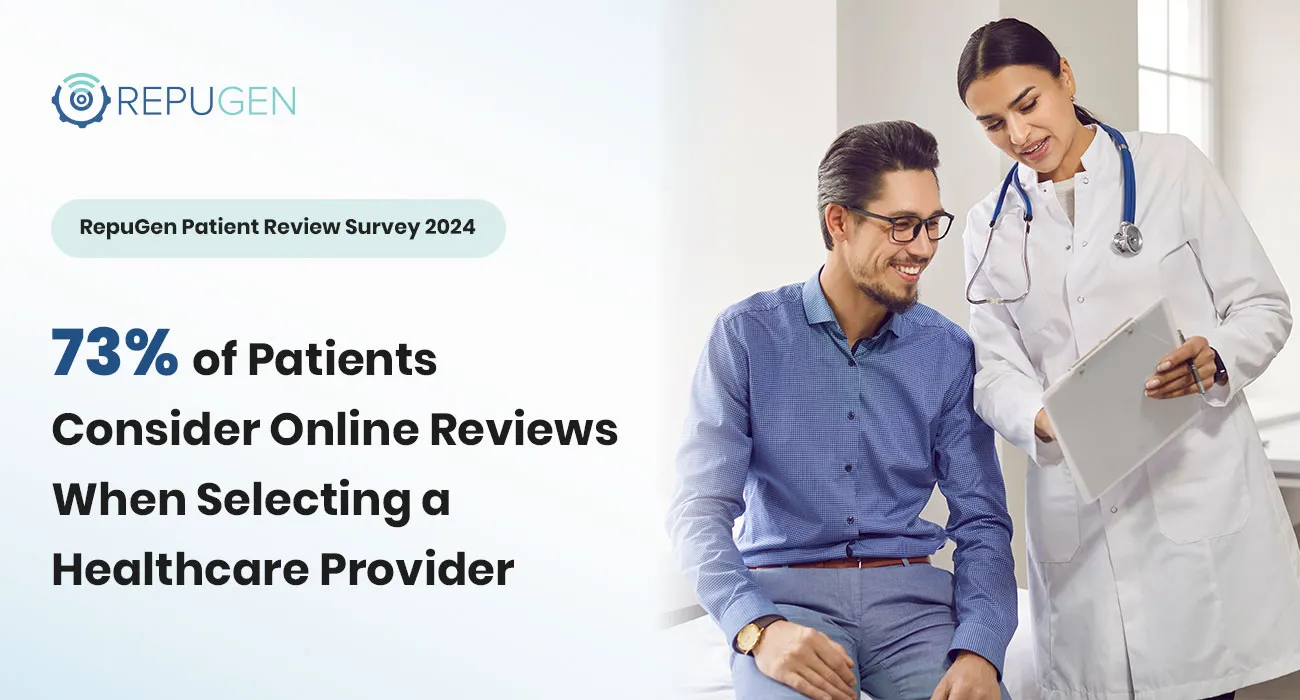Table of Contents
- Do patients consider online reviews when selecting a healthcare provider?
- What are the most important factors of online reviews that patients consider when selecting a healthcare provider?
- In what order do patients consider these online review factors?
- What is the minimum star rating that patients prefer when considering a healthcare provider?
- How many reviews do patients typically read before forming an opinion about a healthcare provider?
- When do patients consider an online review too old or outdated?
- Would patients consider selecting a healthcare provider with no online reviews?
- Which review platforms are patients typically aware of for assessing healthcare providers?
- What platforms do patients primarily check reviews on when evaluating a healthcare provider?
- How many review platforms do patients usually check before making a decision?
- Do patients verify NAP (Name, Address, Phone number) consistency when browsing reviews of healthcare providers?
Online reviews have become an undeniable influence on patient decisions when choosing a healthcare provider. Understanding how patients utilize these reviews is essential for healthcare providers to effectively manage their online reputation and attract new patients.
Recognizing this, we conducted a comprehensive survey in 2024 across the United States to gain deeper insights into patient behavior regarding online reviews for healthcare providers. This report analyzes the valuable responses from 1,426 participants, providing healthcare providers with crucial information to navigate the online review landscape effectively.
Who We Surveyed
Our survey gathered responses from a diverse group of individuals across the United States. Here's a breakdown of some key demographic findings:
- Gender: While the survey has close to equal participation from both genders, a slightly higher percentage of females (52.95%) responded compared to males (47.05%).
- Age: The survey primarily captured responses from adults, with the largest group (35.56%) falling between 30-44 years old. This is followed by those aged 45-60 (26.19%) and above 60 (22.92%).
- Income: The income distribution reveals a good mix of participants across various income levels. The most well-represented group falls within the $25,000 - $49,999 annual income range (21.01%). There's a significant presence in the middle-income category (combined total of 38.75% for $25,000 - $74,999).
- Region: Participation came from all major regions of the United States, with a somewhat even distribution across the East Coast (South Atlantic at 20.54% and Middle Atlantic at 20.03% being the highest).
- Device Usage: The data indicates a strong preference for mobile devices when accessing the survey. Nearly half (49.04%) used iOS phones/tablets, with a similar number (45.14%) using Android devices. Desktop and laptop usage was considerably lower, with Windows having a slight edge over Mac OS (3.90% vs 1.70%).
When was the last time patients visited a healthcare provider?
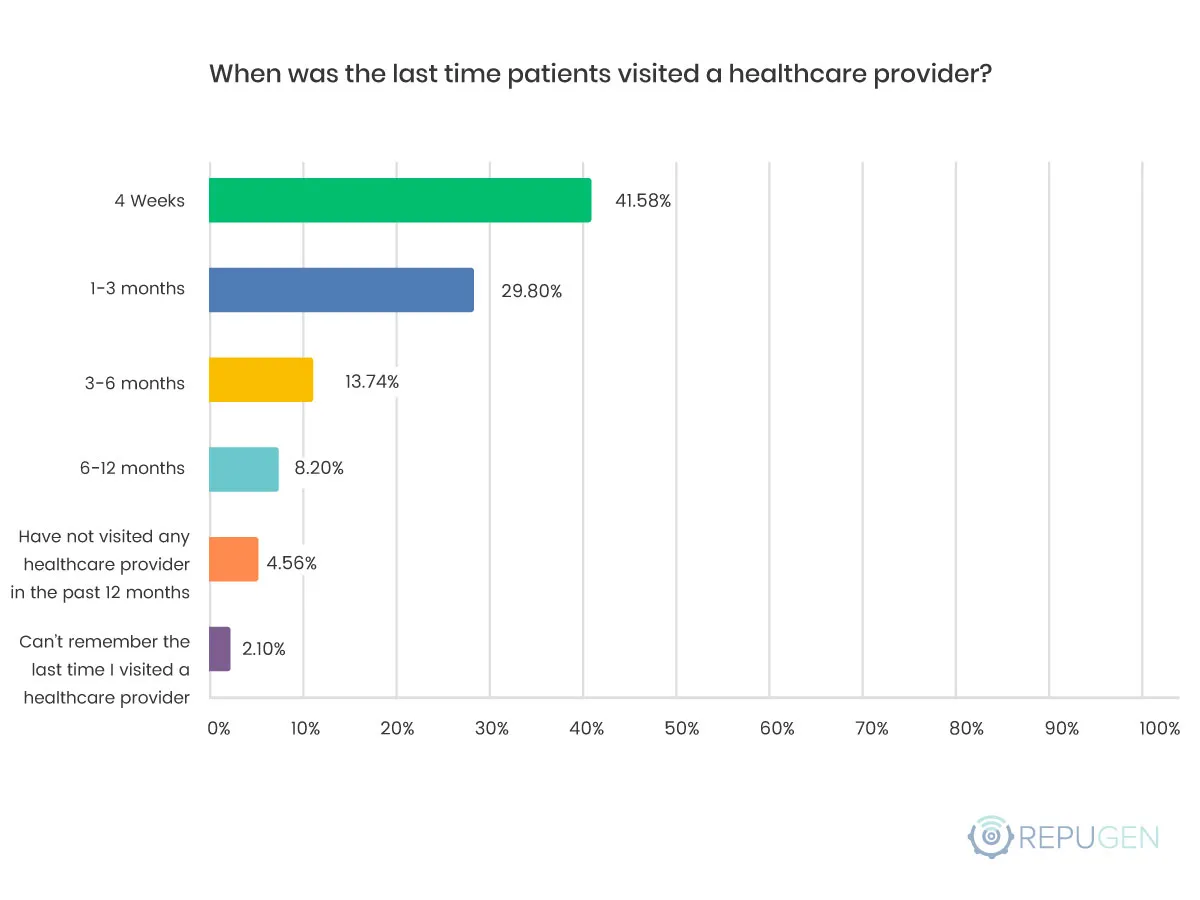
Key Findings
- Frequent Healthcare Utilization: A significant portion of respondents (71.38%) have visited a healthcare provider within the past 3 months. This suggests a proactive approach to healthcare among a large portion of the surveyed population.
- Strong Engagement Within 6 Months: Over 85% of respondents have seen a healthcare provider within the past 6 months. This reinforces the notion of frequent patient interaction with the healthcare system.
- Overwhelming Majority Visited in Past Year: Nearly 93.5% of respondents reported a visit to a healthcare provider within the last year. This high percentage underscores the overall active engagement of the surveyed population with healthcare services.
Inferences and Applications:
The survey findings indicate a population that prioritizes regular healthcare, with a significant portion (71.38%) having visited a provider in the past 3 months. This high level of engagement offers valuable opportunities for healthcare providers:
- Tailored Communication: This high level of engagement empowers healthcare providers to tailor communication strategies. Reminders about upcoming checkups or screenings become even more relevant.
- Optimized Scheduling: Understanding the distribution of visits (e.g., higher concentration in the past 3 months) allows for optimized appointment scheduling and resource allocation.
- Seasonal Trends: Analyzing data over a longer period could reveal seasonal trends in patient visits, informing staffing adjustments or targeted outreach campaigns during peak seasons.
What factors do patients consider when choosing a healthcare provider?
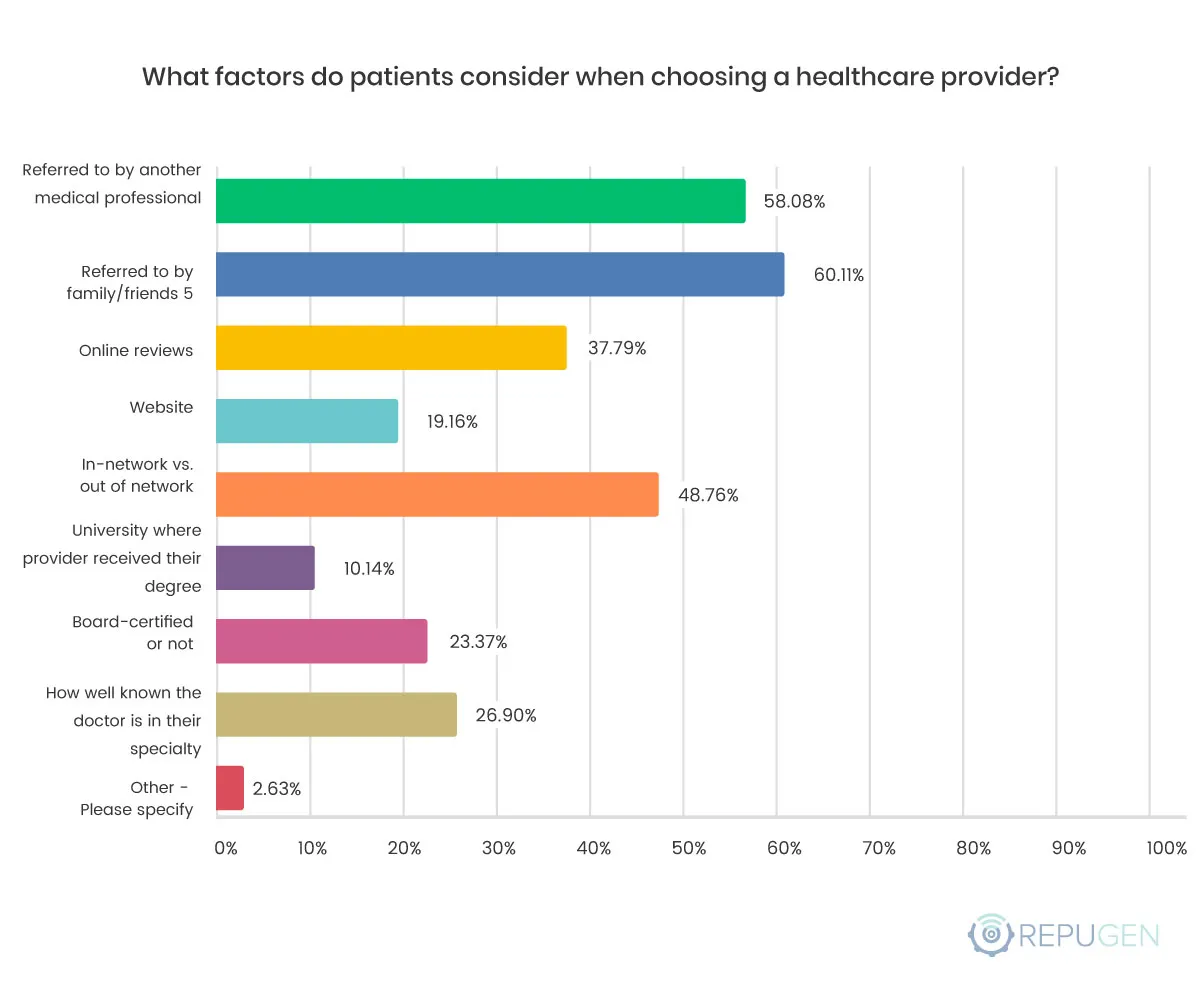
Key Findings
- Word-of-Mouth Reigns Supreme: Referrals from family and friends (60.11%) and medical professionals (58.08%) are the top two considerations. This highlights the enduring power of trust and personal recommendations in healthcare decisions.
- Network Matters: Nearly half (48.76%) consider whether a provider is in-network with their insurance, indicating cost as a significant factor.
- Online Reviews Gain Traction: While online reviews (37.79%) rank fourth, they still hold considerable weight in influencing patient decisions.
Inferences and Application
- Leverage Referrals: Promote "Patient Referral" programs and gather positive testimonials from satisfied patients to build trust and credibility for potential new patients (referrals from family/friends at 60.11%).
- Embrace Online Reviews: Encourage satisfied patients to leave positive reviews on reputable platforms and respond thoughtfully to all reviews (online reviews at 37.79%).
- Showcase Positive Reviews: Feature positive reviews prominently on websites and marketing materials to further build trust and attract new patients.
Among the factors influencing patients' choices, which ones are rated as most significant?

Key Findings
This combined analysis of patient responses from Questions 2 and 3 reveals a consistent pattern in how patients choose healthcare providers. Here are the key findings:
- Word-of-Mouth Dominates: Referrals remain the top consideration, with endorsements from medical professionals (30.02%) now slightly exceeding those from family and friends (21.42%). This highlights the enduring importance of trust and personal recommendations in healthcare decisions.
- Network Still Matters: Cost remains a significant factor, with nearly a quarter (26.32%) prioritizing in-network providers.
- Online Reviews Gaining Ground: While online reviews (13.12%) rank lower than referrals and network status, they still hold weight in influencing patient decisions. This suggests a growing trend of patients seeking online verification and validation before choosing a provider.
Inferences and Application
- Solidify Referral Strategies: Prioritize referrals by fostering strong relationships with medical professionals and encouraging patient recommendations. Consider implementing a referral program.
- Build Trust and Credibility: Showcase qualifications and experience through testimonials and clear communication.
- Embrace Online Reputation Management: Acknowledge online reviews (13.12%). Encourage satisfied patients to leave positive reviews and respond professionally to all feedback (positive and negative). Claim and manage online profiles on major platforms.
- Address Cost Concerns: Ensure your practice is listed with major insurance providers and clearly display your in-network status (26.32%).
Do patients consider online reviews when selecting a healthcare provider?
Key Findings
While online reviews remain a significant influence, there's a noteworthy trend to acknowledge. The data shows a decrease in patients relying solely on online reviews (72.71% in 2024 compared to 75% in 2022). This shift could be attributed to several factors, such as:
- Increased awareness of fake reviews: Patients might be more critical of online reviews due to growing awareness of fake reviews and the potential for manipulation.
- Greater emphasis on other factors: The importance of referrals from family/friends (around 60%) and medical professionals (around 30%) might be gaining traction alongside online reviews.
Inferences and Application
While the decrease in sole reliance on online reviews is noteworthy, a significant majority (over 72%) of people still consider them a major influence. This means online reviews remain a powerful tool for attracting new patients. Think of it like this: even a small decline in the number of people who eat pizza every day wouldn't make pizza restaurants suddenly stop advertising pizzas.
Therefore, these findings underscore the importance of a multifaceted approach to patient acquisition. Here's how healthcare providers can still leverage online reviews effectively:
- Embrace Online Reputation Management (ORM): Claim and manage profiles on major healthcare review platforms, encourage positive reviews, respond promptly and professionally to all feedback, and showcase positive reviews prominently.
- Solidify Referral Strategies: Build strong relationships with referring medical professionals and encourage satisfied patients to recommend your services. Consider a referral program.
- Showcase Credibility: Highlight your qualifications and experience to build trust with potential patients. Positive testimonials from satisfied patients can be particularly effective.
What are the most important factors of online reviews that patients consider when selecting a healthcare provider?

Key Findings
- Review Sentiment Matters Most: Nearly half (47.19%) of patients prioritize the sentiment expressed in reviews. This indicates a strong focus on the overall tone and experience described by other patients.
- Star Ratings Remain Important: While not the top factor, overall star ratings (27.65%) still hold significant weight in influencing patient decisions.
- Other Factors: Although not the top choices, patients also consider responses to reviews (13.93%), review recency (8.42%), and the total number of reviews (2.81%) when making their decision.
Inferences and Application
- Focus on Patient Experience: Prioritize providing excellent care and service to solidify patient experiences. This directly translates to positive reviews and a stronger online reputation.
- Maintain a High Star Rating: A strong average star rating is crucial to attract potential patients. Consistently deliver high-quality care to achieve this.
- Encourage Detailed Reviews: While a positive star rating is vital, go beyond that. Encourage satisfied patients to leave detailed reviews elaborating on their positive experiences. This builds trust and credibility with potential patients reading the reviews.
- Respond to All Reviews: While responding wasn't the top factor, it still holds value. Address both positive and negative reviews professionally. This demonstrates responsiveness and a commitment to patient satisfaction, potentially influencing future patients' perception.
- Monitor Reviews Regularly: Regularly monitor online reviews to identify areas for improvement and address any recurring concerns raised by patients.
- Maintain a Recent Review Stream: Encourage patients to leave recent reviews to keep your profile fresh and show ongoing patient satisfaction.
In what order do patients consider these online review factors?
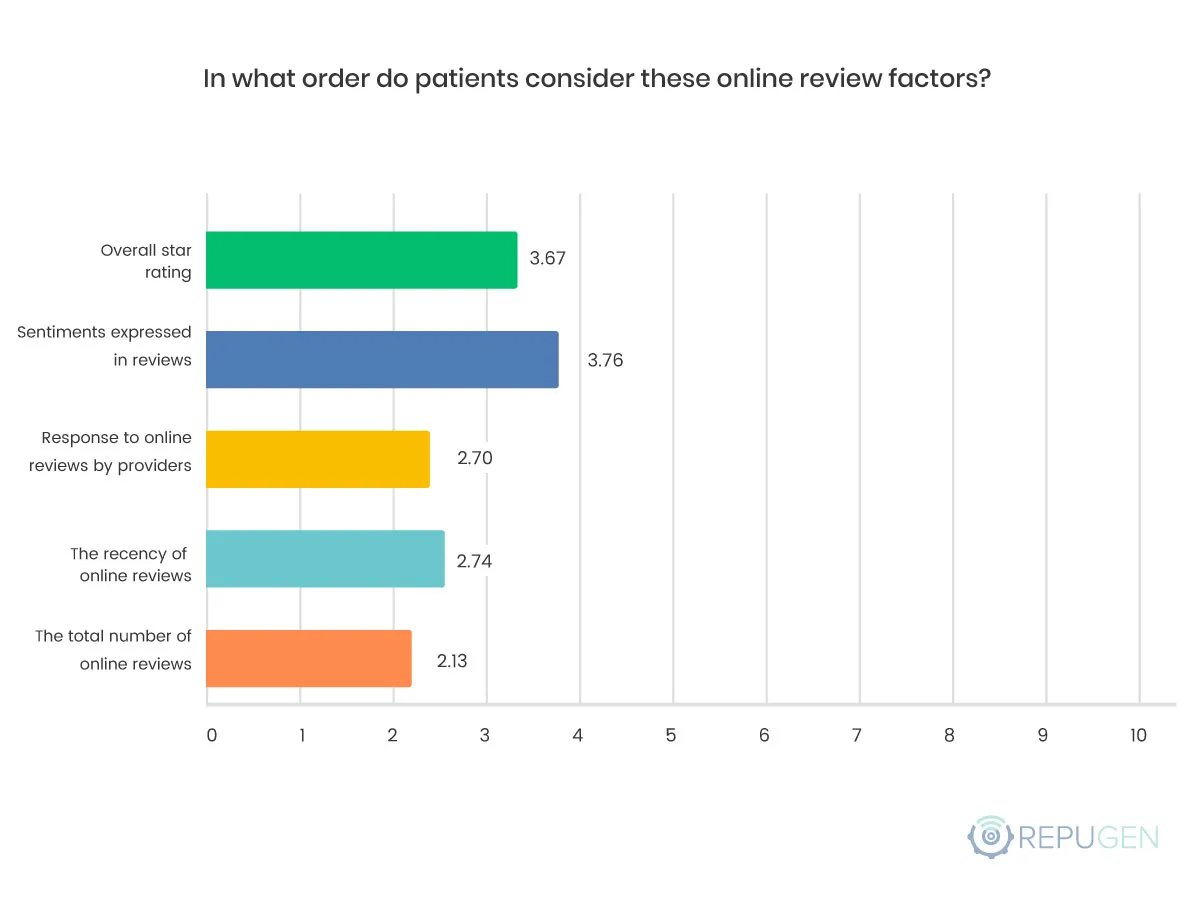
Key Findings
- Initial Star Rating Scan: Patients likely begin by looking at the overall star rating of a healthcare provider. This provides a quick and easy gauge of overall patient satisfaction.
- Deeper Dive into Sentiment: Following the initial star rating scan, patients delve deeper by reading the reviews themselves. The sentiment expressed in the reviews (47.19% importance in Q5) becomes crucial at this stage, allowing patients to understand the specific experiences and perspectives of previous patients.
- Considering Additional Factors: While star ratings and detailed reviews are crucial, patients also delve deeper. They value providers who actively respond to reviews (both positive and negative), suggesting a commitment to feedback. Additionally, the recency of reviews holds some weight, as patients prefer more up-to-date information. Finally, the total number of reviews, particularly a large volume of positive ones, can influence patients by building trust and credibility.
Inferences and Application
- Maintain a Strong Star Rating: A high average star rating is essential for attracting potential patients. Focus on delivering excellent care to consistently receive positive reviews.
- Encourage Detailed Reviews: While a positive star rating is vital, encourage satisfied patients to leave detailed reviews elaborating on their positive experiences. This can build trust and credibility with potential patients who are reading the reviews.
- Respond to All Reviews: While responding to reviews wasn't the top-ranked factor (13.93% in Q5), addressing both positive and negative reviews professionally demonstrates responsiveness. It also allows you to clarify any misunderstandings and showcase your commitment to patient satisfaction.
The combined analysis of Q.5 and Q.6 highlights the importance of a two-pronged approach to online reviews:
- Maintain a Strong Overall Star Rating: This serves as a first impression for potential patients.
- Encourage Detailed Reviews with Positive Sentiment: Detailed positive reviews provide valuable insights into patient experiences and build trust with potential patients.
By implementing these data-driven strategies, healthcare providers can effectively leverage online reviews to build a strong online reputation and attract new patients.
What is the minimum star rating that patients prefer when considering a healthcare provider?
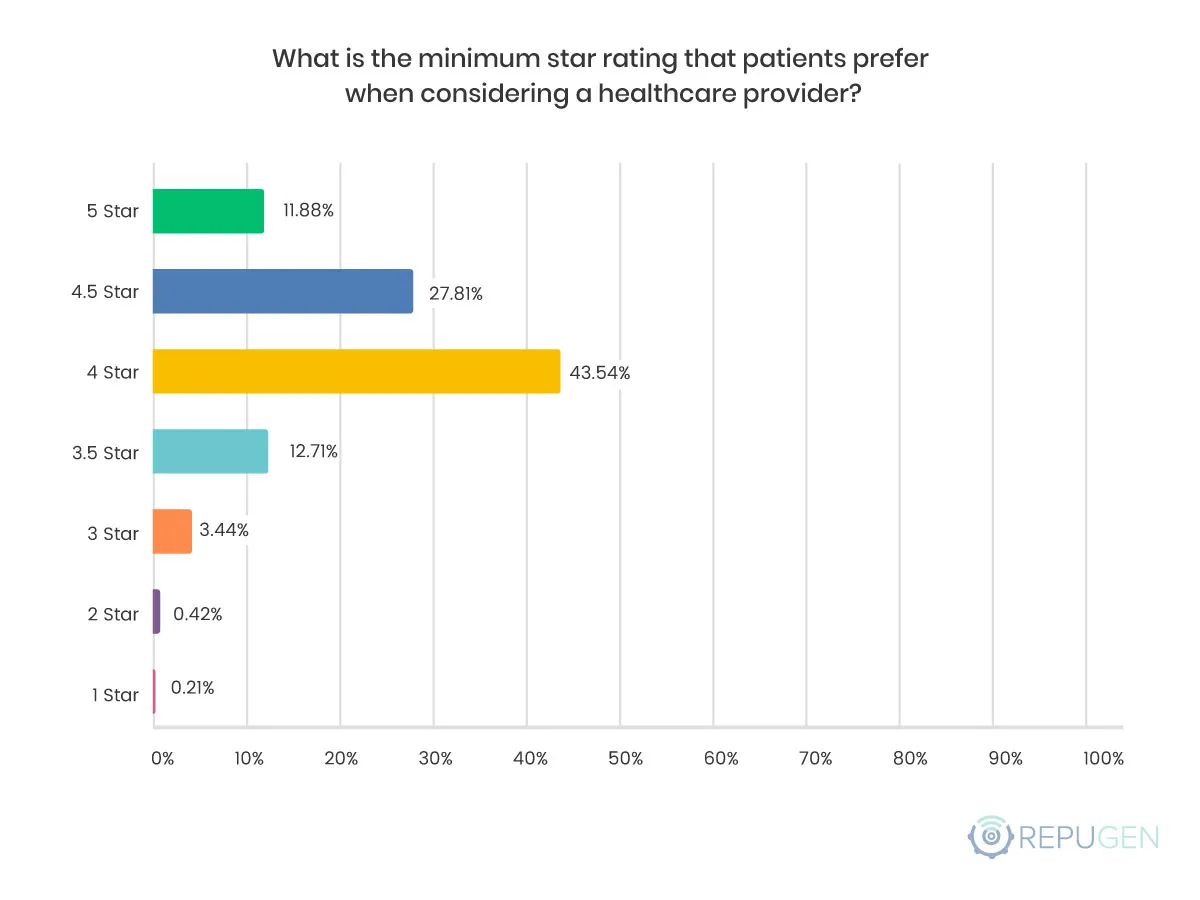
Key Findings
This data reveals a crucial aspect of online reviews for healthcare providers: the significant influence of star ratings:
- High Bar for Consideration: A substantial majority of patients (83.23%) require a minimum rating of 4 stars to even consider an online review. This highlights the importance of maintaining a very high average star rating.
- Threshold for Choosing a Provider: Nearly all patients (95.94%) require at least a 3.5-star rating to seriously consider a healthcare provider. Ratings below this threshold can significantly deter potential patients.
Inferences and Application
These findings underscore the critical need for healthcare providers to prioritize maintaining a strong star rating:
- Focus on Delivering Excellent Care: Providing exceptional care and service is the foundation of a high star rating. Satisfied patients are more likely to leave positive reviews, boosting your online reputation.
- Proactively Address Patient Concerns: Actively address any patient concerns promptly and professionally. This can help prevent negative reviews and maintain a high overall rating.
- Monitor and Respond to Reviews: Regularly monitor online reviews and respond to both positive and negative reviews in a timely and professional manner. Demonstrating responsiveness can mitigate the impact of negative reviews and potentially turn them into positive experiences.
How many reviews do patients typically read before forming an opinion about a healthcare provider?
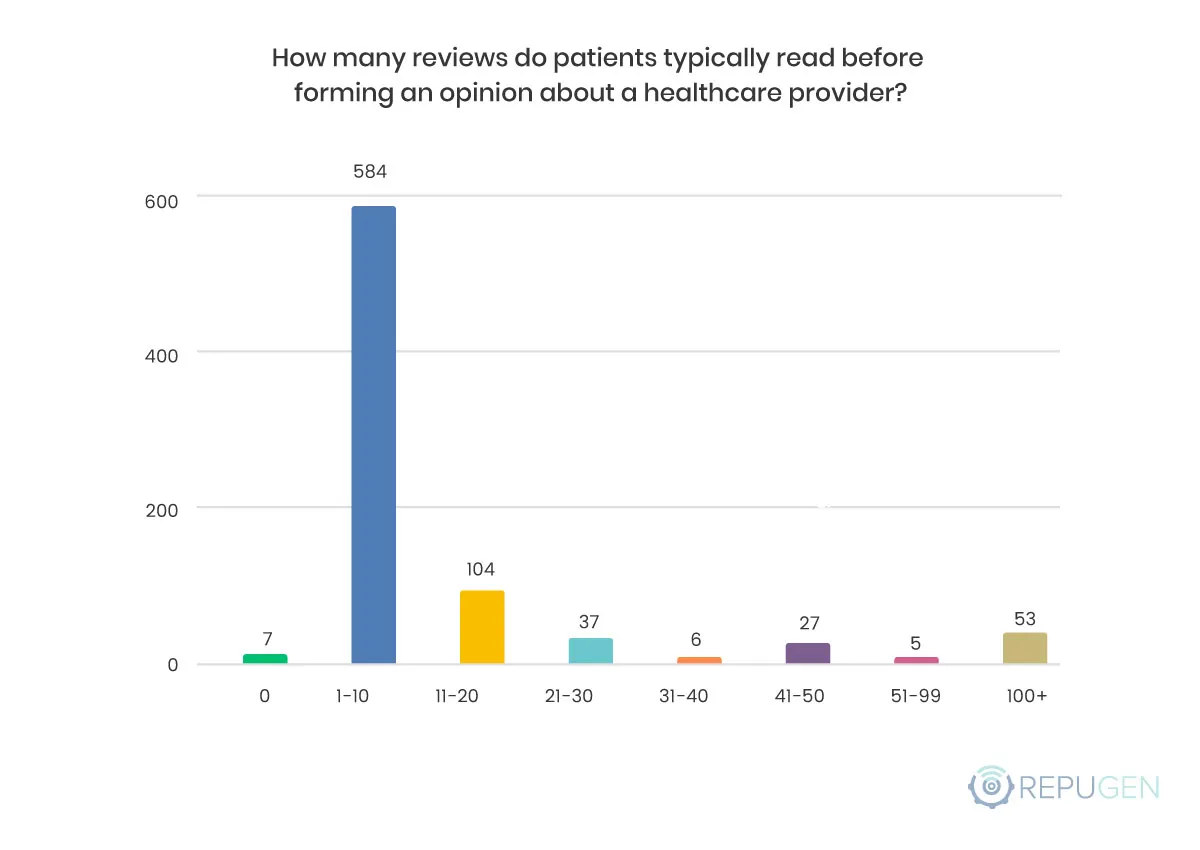
Key Findings
- Predominance of 1-10 Reviews: The vast majority of patients (70.96%) fall within the 1-10 online review range when making decisions. This suggests a focus on a manageable number of reviews for forming an opinion.
- Importance of Review Volume: A significant portion of patients (78.61%) check at least 5 online reviews, and nearly half check at least 10 reviews. This highlights the growing importance of a substantial body of positive reviews to build trust with potential patients.
Inferences and Application
- Focus on Building a Strong Review Base: Actively encourage satisfied patients to leave positive reviews on reputable platforms. A consistent flow of positive reviews can build trust with potential patients considering your practice.
- Monitor Review Trends: Regularly monitor online reviews to identify areas for improvement and address any recurring concerns raised by patients. This demonstrates responsiveness and a commitment to patient satisfaction, potentially encouraging more positive reviews.
- Respond to All Reviews: While responding to reviews wasn't the top-ranked factor(13.93% in Q5), addressing both positive and negative reviews professionally demonstrates responsiveness (Q5). This can mitigate the impact of negative reviews and potentially turn them into positive experiences.
When do patients consider an online review too old or outdated?
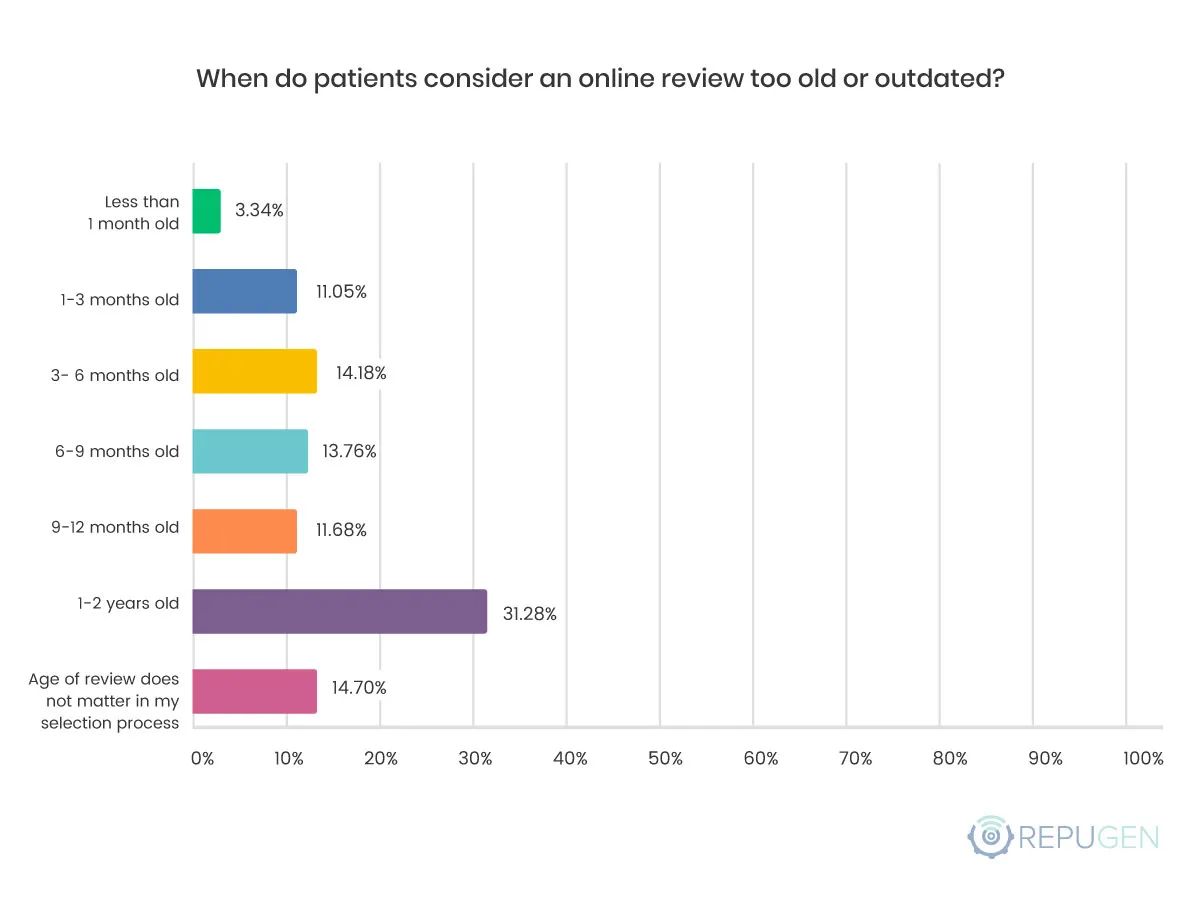
Key Findings
- Majority Considers Review Age: A substantial majority of patients (85.30%) consider the age of an online review when making decisions. This highlights the value of having a consistent flow of fresh reviews.
- Threshold for Review Age: Over a third of patients (31.28%) consider a review to be "too old" if it's more than a year old. This suggests a preference for more recent patient experiences.
Inferences and Application
These findings emphasize the importance of a strategy focused on acquiring recent positive reviews:
- Encourage Consistent Reviews: Actively encourage satisfied patients to leave reviews regularly, not just after their initial visit.
- Respond Promptly to Reviews: Addressing both positive and negative reviews promptly demonstrates responsiveness and a commitment to patient satisfaction. This can also encourage more recent reviews from satisfied patients who see your engagement.
- Highlight Recent Reviews: When possible, showcase recent positive reviews on your website and marketing materials. This emphasizes the timeliness of patient experiences and builds trust with potential patients.
Would patients consider selecting a healthcare provider with no online reviews?
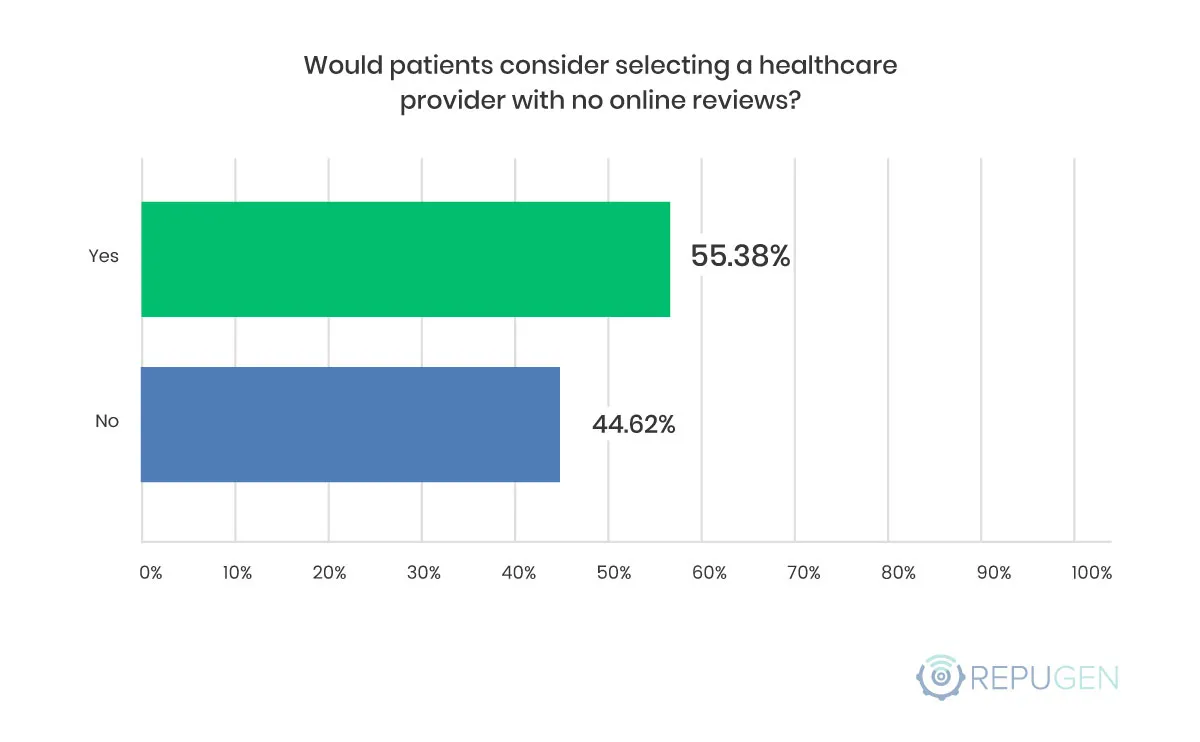
Key Findings
This data reveals a shift in patient behavior regarding the absence of online reviews:
- Increased Tolerance for No Reviews: A majority of patients (55.38%) in 2024 are now willing to consider a healthcare provider with no online reviews. This is a significant increase compared to 2022 (48%).
Inferences and Application
This finding suggests a growing openness to providers without online reviews. However, it doesn't diminish the importance of positive reviews. Here's a two-pronged approach:
- Maintain a Strong Review Presence: If you have a good foundation of positive reviews, continue to encourage satisfied patients to leave reviews and manage your online reputation effectively. This can still significantly influence patient decisions.
- Highlight Credibility Through Other Channels: Since some patients are now more open to providers without reviews, focus on establishing credibility through other channels:
- Emphasize qualifications and experience on your website and marketing materials.
- Showcase professional affiliations and certifications.
- Encourage patient referrals through satisfied existing patients. (Refer to Q2 & Q3 for additional non-review factors patients consider)
By implementing these data-driven strategies, healthcare providers can adapt to the evolving landscape of patient expectations. A strong online review presence remains valuable, but effectively communicating credibility through other channels can also influence patients who are open to considering providers without a wealth of online reviews.
Which review platforms are patients typically aware of for assessing healthcare providers?
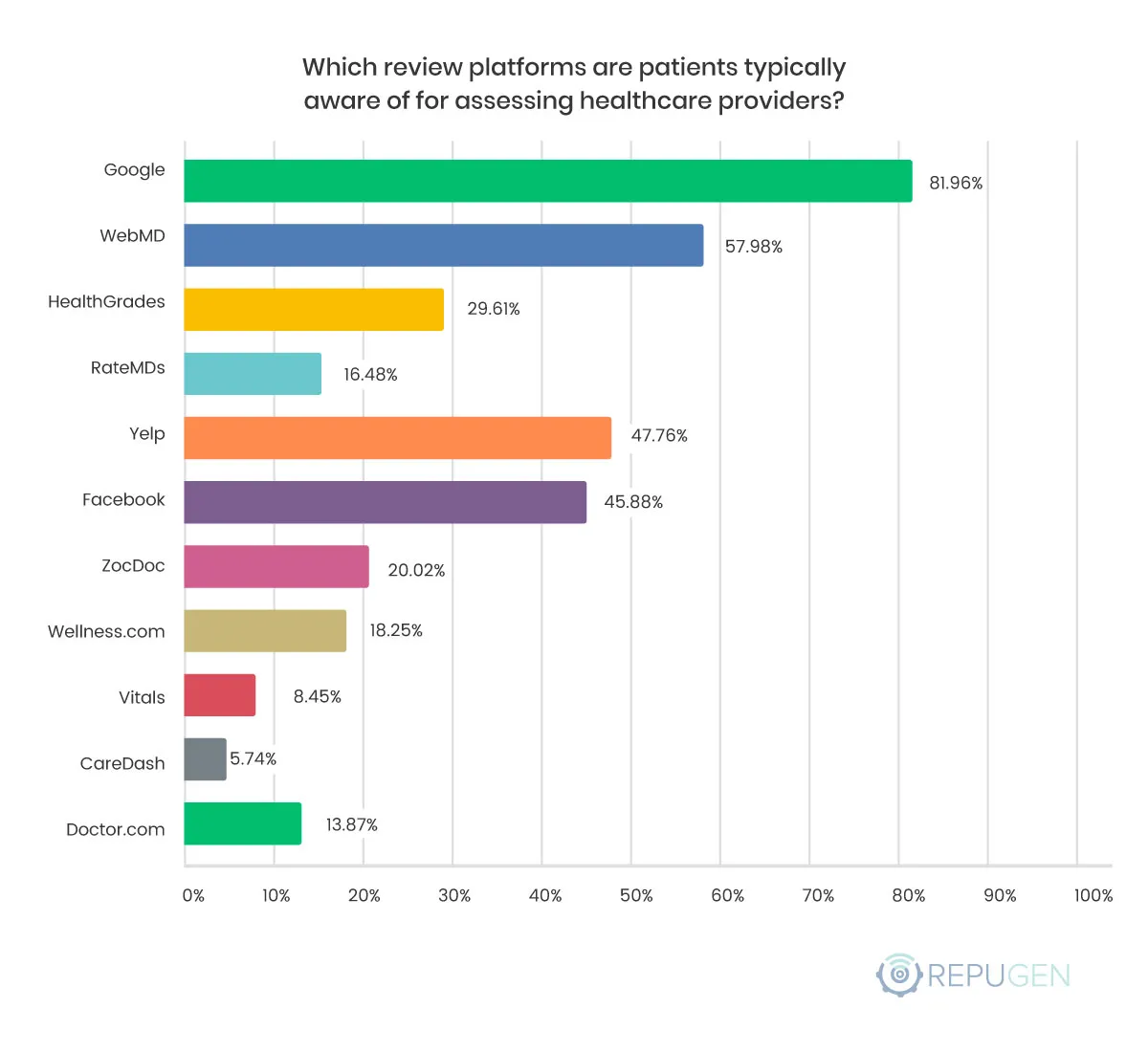
What platforms do patients primarily check reviews on when evaluating a healthcare provider?
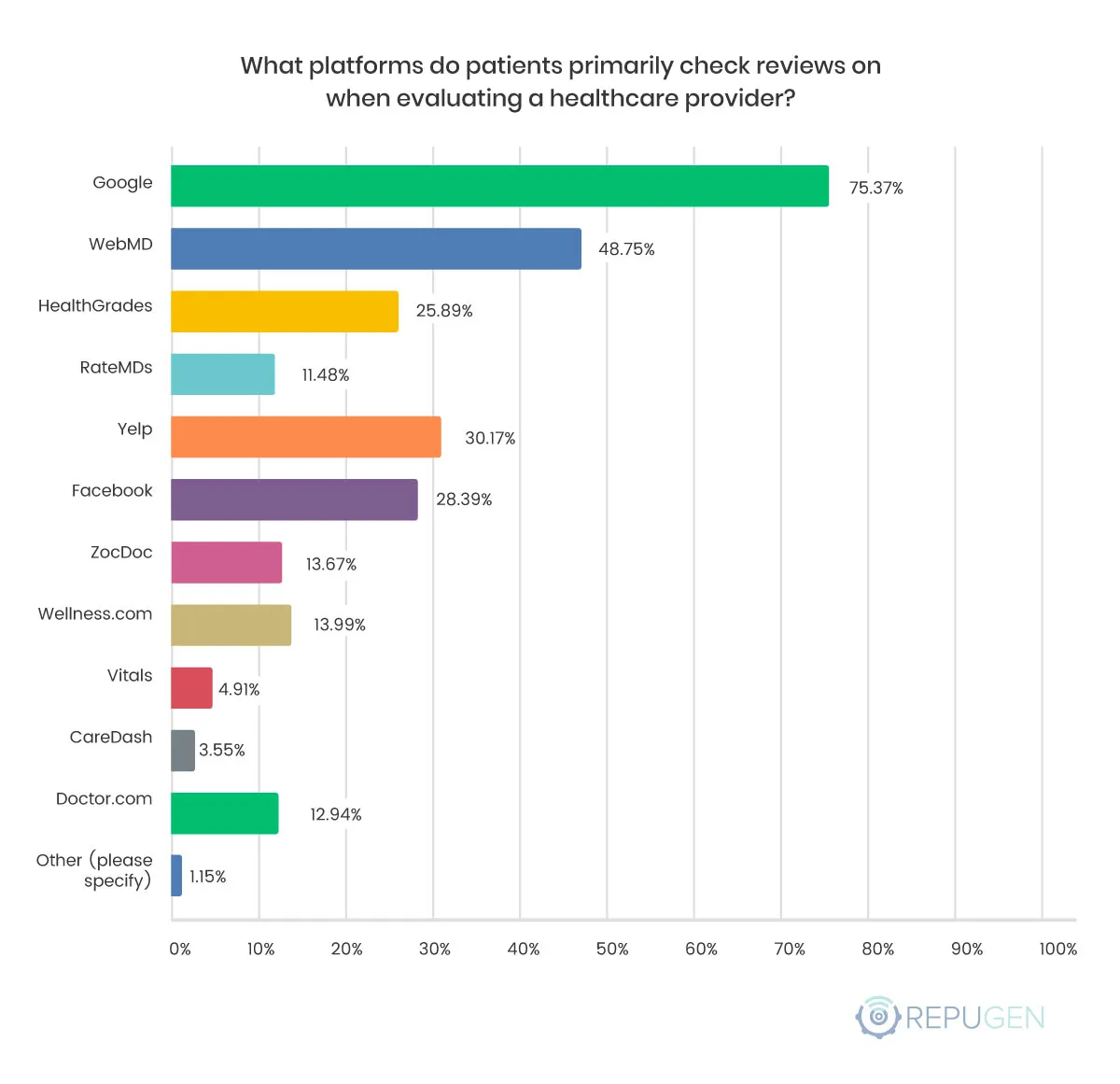
Key Findings: Online Review Platform Awareness and Usage
This combined analysis of platform awareness and platform usage for research provides valuable insights into patient behavior regarding online review platforms:
- Predominant Awareness of Google Reviews: A vast majority of patients (81.96%) are familiar with Google Reviews, making it the most recognized platform. This is further reinforced by patient usage, with 75.37% checking Google reviews when researching providers.
- WebMD and HealthGrades Hold Weight: While not as prevalent as Google, WebMD (57.98% awareness, 48.75% usage) and HealthGrades (29.61% awareness, 25.89% usage) are still significant platforms for patients.
Secondary Review Platforms:
- Yelp Usage Differs from Awareness: Despite moderate awareness (47.76%), Yelp usage for research is lower (30.17%). This suggests patients might be aware of Yelp but rely on it less for decision-making compared to other platforms.
- Other Platforms: Facebook (awareness: 45.88%, usage: 28.39%), ZocDoc (awareness: 20.02%, usage: 13.67%), and others play a smaller role, but still hold some relevance for a portion of patients.
Inferences and Application
This data highlights the importance of a multi-platform review management strategy:
- Focus on Google Business Profile: Given its dominance in both awareness and usage, prioritize claiming and managing your profile on Google Business Profile. Encourage satisfied patients to leave reviews there and respond promptly to all feedback.
- Maintain a Presence on Key Platforms: While Google is crucial, consider claiming profiles and managing reviews on WebMD, HealthGrades, and Facebook to maintain a broader online presence.
- Track Review Trends Across Platforms: Monitor reviews across all relevant platforms to identify areas for improvement and address any recurring patient concerns.
How many review platforms do patients usually check before making a decision?

Key Findings
- Multi-Platform Review Checking: A significant majority of patients (86.12%) consult at least two online review sites when researching healthcare providers. This highlights the importance of a strong online reputation across multiple platforms.
Inferences and Application
- Focus Beyond Just One Platform: Don't solely focus on a single platform like Google Reviews, even if it's dominant. Patients actively consult multiple platforms. Other surveys also suggest that consumers usually check two or more reviews sites before selecting a business.
- Claim and Manage Profiles on Key Sites: Claim and manage profiles on the most relevant platforms(e.g., WebMD, Healthgrades, Facebook).
- Encourage Reviews Across Platforms: Encourage satisfied patients to leave positive reviews on various platforms they use, not just your preferred one.
- Monitor Reviews Consistently: Regularly monitor reviews across all platforms to address concerns and maintain a positive online presence.
Do patients verify NAP (Name, Address, Phone number) consistency when browsing reviews of healthcare providers?
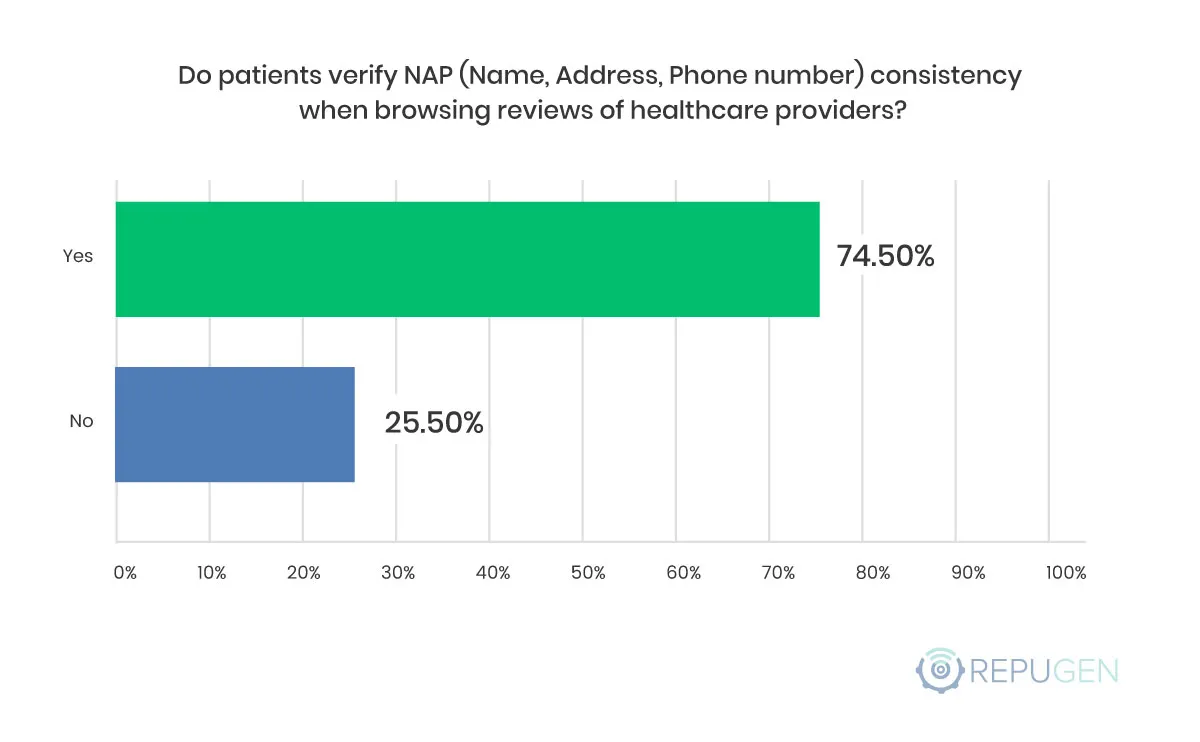
Key Findings
- Importance of NAP Consistency: A significant majority of patients (74.50%) actively verify if a healthcare provider's address and phone number match information on their website. This highlights the importance of consistent NAP (Name, Address, Phone number) across all online listings.
Inferences and Application
- NAP Management Across Platforms: Ensure your NAP information (name, address, phone number) is identical across all online directories, review platforms, and your website. Inconsistencies can cause confusion and deter patients from contacting you, ultimately leading them to seek care from your competitors.
- Utilize NAP Management Tools: Consider using NAP management tools to simplify the process of keeping your information consistent across multiple platforms.
- Regularly Monitor Listings: Regularly monitor your online listings for accuracy and update any discrepancies promptly.
Summary
Choosing a new doctor can feel like navigating uncharted territory. Traditionally, word-of-mouth recommendations from friends and family were the golden ticket. But times are changing. The survey revealed that almost 73% of patients are turning to online reviews to help them make this important decision.
The survey went a step further, uncovering what truly resonates with patients in these reviews. It turns out, the overall sentiment – positive or negative – carries the most weight. This emphasizes the importance of creating positive patient experiences, ensuring each interaction builds trust and satisfaction. The survey also highlighted the power of star ratings. Just like flipping through a travel guide, patients tend to gravitate towards doctors with consistently high ratings, ideally averaging 4 stars or above.
So, the next time you wonder how patients choose their doctors, remember – online reviews are an influential voice. By focusing on positive patient experiences and maintaining a strong online reputation, healthcare providers can navigate this evolving landscape and attract new patients with confidence.

